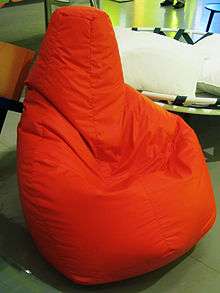Bean bag chair

A bean bag chair is a large fabric bag, filled with polystyrene beads (Sacco chair),[2] dried beans, or a similar substance.[3] The product is an example of an ‘anatomic chair’.[1] The shape of the object is set by the user. Although designed to be a chair, due to its amorphous nature it is often confused with tuffets and ottomans.
History
Sacco,[1] the first artifact of that kind, was introduced in 1968 by three Italian designers: Piero Gatti, Cesare Paolini and Franco Teodoro.[1] The object was created in the Italian Modernism movement.[4] Being a post war era phenomenon, Italian modernism’s design was highly inspired with new available technology. Post war technology allowed an increase in the processes of production, by introducing new materials such as polystyrene. The idea of mass-produced goods made within an inexpensive price range appealed to consumers. It therefore created the need for a revolution in the creative and manufacturing process. ‘The designer was an integral member of a process that included marketing as well as engineering’ (Raizman 284).[4] The inspiration left by Corradino D’Ascano’s Vespa design for the Piaggio Corporation in 1946, added value to the essence of the designer. With successful designs, brands could sell more products, and therefore the identity of the designer played an important advertising role.[4] Another important figure of the Italian modernism period was Gio Ponti. Inspired by modernism's art movements, Ponti created new forms of objects. His asymmetrically balanced designs freed the Italian objects form their classic representations. The designer promoted Italian designs on famous exhibitions called ‘Milan Triennale’ : “These exhibitions, organized as early as the 1920s … were responsible for increasing the visibility of Italian design in an international setting ” (Raizman 285).[4] After becoming an editor of the Domus (magazine) in 1947, Ponti contributed to not only Italian design of that time, but also : “the human and creative element in modern industrial design as well as its practical, economic and social benefits.”(Raizman 285)[4]
Piero Gatti, Cesare Paolini and Franco Teodoro, inspired by their designer predecessors, came up in 1968 with the design of Sacco the ‘shapeless chair’. Although it was not the first design of an amorphous chair in Italian history, Sacco was the first successful product created in partnership with Zanotta. The predecessor of the product called “Blow” had a major design flaw of not being able to sustain its form and therefore never reached production. Sacco picked up that flaw and with the use of leather for exterior and right placed stitching. It is worth mentioning that the use of leather was not coincidental as at that time the textile was an Italian national pride product.[4] The target user of the chair was the lax, hippie community and their non-conformist household. "In an era characterized by the hippie culture, apartment sharing and student demonstrations, the thirty-something designers created a nonpoltrona (non-chair) and thus launched an attack on good bourgeois taste."[1]
Actor-network theory[5] analysis of Sacco
As mentioned before, Italian modernism redefined some classic design models into new, more functional products. Sacco’s design was aimed at mass-media consumption. Its light weight and flexible nature allowed easy shipping. The bean bag chair consisted of a leather exterior that at the same time was a vessel for polystyrene beds. The idea of the design was for the product to shape around the user. Therefore, following the ANT method, the user of the bean bag artifact became the integral part of the objects’ agency. In comparison, a classic ‘chair’ design, can still act as a chair without the user’s input. The network of such an object functions around the designer, producer, manufacturer and user, but for its agency (acting) does not need the user. Sacco on the other hand, cannot fully function as a chair without the user, as the user gives it the final shape. Thanks to its flexibility the object can act as a stool, futon or a pillow. Since it was not the aim of its design this would be considered an anti-program use of the object.[5]
Other bean bag chair products inspired by Sacco
Other designers have followed the ‘shapeless’ chair design, creating a range of inspired products that take after Sacco.[6] Amongst many, the most successful contemporary model would be Jukka Setala’s Fatboy. The product launched in 2002 brought the Finnish designer global recognition. The new form of the bean bag chair has less stitching and a more geometrical take in the means of shape. It has also a EPS filling which is more durable than PVC.[7]
External links
- Vitra Design Museum
- Museum of Modern Art, New York
- Victoria & Albert Museum, London
- Centre Pompidou, Paris
- Museum of Applied Arts & Sciences, Sidney
References
- 1 2 3 4 5 Vitra Design Museum. "Sacco". Retrieved 25 September 2014.
- ↑ "Definition of beanbag in English". Oxford Dictionary. Retrieved 10 January 2014.
- ↑ "English definition of "beanbag"". Cambridge Dictionary. Retrieved 10 January 2014.
- 1 2 3 4 5 6 Raizman, David (2010). "Part V: Humanism and Luxury: International Modernism and Mass Culture after Word War II (1945-1960)". In May, Susie. History of Modern Design Second Edition. Laurence King Publishing. pp. 256–306. ISBN 978-1-85669-694-4.
- 1 2 Fallan, Kjetil (2010). "Chapter 2: Theory and Methodology". Design history understanding theory and method. Berg Oxford International Publishers. pp. 65–78. ISBN 978-1-84788-537-1.
- ↑ Griffiths, Sally (2 June 2009). "How to bag a beanbag chair". The Guardian. Retrieved 10 January 2014.
- ↑ Fatboy (2002). "Fatboy original". Fatboy. Retrieved 16 October 2014.